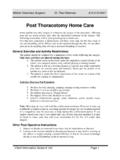Transcription of Vulvodynia: A Self Help Guide - ISSWSH
1 vulvodynia : A self - help Guide Introduction .. 1 Section I: Learning the Basics .. 2 Gynecological Anatomy Normal and Abnormal Vulvovaginal Symptoms Vulvar self -Examination Section II: Understanding vulvodynia .. 9 What is vulvodynia ? What Causes vulvodynia ? How is vulvodynia Diagnosed? Co-Existing Conditions How is vulvodynia Treated? self - help Strategies for Vulvar pain Section III: Understanding Chronic pain .. 17 How We Feel pain When pain Becomes Chronic Coping with Chronic pain Section IV: Quality of Life Issues .. 20 Overcoming Challenges in Your Intimate Relationship Keeping Sexual Intimacy Alive When to Seek Counseling Special Issues for Single Women Family Life Issues Section V: Getting the Most Out of Your Medical Care .. 27 How to Find a Health Care Provider Educate Yourself How to Communicate Effectively with Your Health Care Provider Seeking a Second Opinion or Changing Doctors Section VI: Advice from Women with vulvodynia .
2 31 Recommended Reading .. 32 This publication is copyrighted by the National vulvodynia Association and fully protected by all applicable copyright laws. Copyright 2016 by the National vulvodynia Association. All rights reserved. The National vulvodynia Association is not a medical authority and strongly recommends that you consult your own health care provider regarding any course of treatment or medication. Table of Contents 1 Welcome to the NVA s self - help Guide for women with vulvodynia . We created this Guide to answer many of your questions about vulvodynia and its treatment, and to offer suggestions for improving your quality of life.
3 First we d like to highlight a few important points. Each woman s experience with vulvodynia is unique, with symptoms ranging from mild to incapacitating. If your pain level is mild, some of the information in this Guide may not apply to you. Some doctors are still unfamiliar with vulvodynia . Many women spend a long time wondering what is wrong with them and see several doctors before they are told they have vulvodynia . An accurate diagnosis is half the battle, so now you can focus your efforts on finding helpful treatments and feeling better. When you start a new treatment, try to be patient and hopeful. There are many treatment options for vulvodynia and no single treatment works equally well for all women. Sometimes progress is slow and you may only notice improvement on a monthly, rather than daily, basis.
4 It is important to participate in treatment decisions and discuss your progress (or lack of it) with your doctor or other health care provider. You know more about how you feel than anyone else. Finally, as you read through this Guide , we recommend that you take notes on topics you would like to discuss with your provider. So, with the above in mind, let s begin! This Guide was written for every woman with chronic pain who thought that she was suffering alone. - Phyllis Mate, NVA co-founder Introduction Introduction .. 1 Section I: Learning the Basics .. 2 Gynecological Anatomy Normal and Abnormal Vulvovaginal Symptoms Vulvar self -Examination Section II: Understanding vulvodynia .. 9 What is vulvodynia ? What Causes vulvodynia ? How is vulvodynia Diagnosed? Co-Existing Conditions How is vulvodynia Treated?
5 self - help Strategies for Vulvar pain Section III: Understanding Chronic pain .. 17 How We Feel pain When pain Becomes Chronic Coping with Chronic pain Section IV: Quality of Life Issues .. 20 Overcoming Challenges in Your Intimate Relationship Keeping Sexual Intimacy Alive When to Seek Counseling Special Issues for Single Women Family Life Issues Section V: Getting the Most Out of Your Medical Care .. 27 How to Find a Health Care Provider Educate Yourself How to Communicate Effectively with Your Health Care Provider Seeking a Second Opinion or Changing Doctors Section VI: Advice from Women with vulvodynia .. 31 Recommended Reading .. 32 This publication is copyrighted by the National vulvodynia Association and fully protected by all applicable copyright laws. Copyright 2016 by the National vulvodynia Association.
6 All rights reserved. The National vulvodynia Association is not a medical authority and strongly recommends that you consult your own health care provider regarding any course of treatment or medication. Table of Contents 1 Welcome to the NVA s self - help Guide for women with vulvodynia . We created this Guide to answer many of your questions about vulvodynia and its treatment, and to offer suggestions for improving your quality of life. First we d like to highlight a few important points. Each woman s experience with vulvodynia is unique, with symptoms ranging from mild to incapacitating. If your pain level is mild, some of the information in this Guide may not apply to you.
7 Some doctors are still unfamiliar with vulvodynia . Many women spend a long time wondering what is wrong with them and see several doctors before they are told they have vulvodynia . An accurate diagnosis is half the battle, so now you can focus your efforts on finding helpful treatments and feeling better. When you start a new treatment, try to be patient and hopeful. There are many treatment options for vulvodynia and no single treatment works equally well for all women. Sometimes progress is slow and you may only notice improvement on a monthly, rather than daily, basis. It is important to participate in treatment decisions and discuss your progress (or lack of it) with your doctor or other health care provider. You know more about how you feel than anyone else. Finally, as you read through this Guide , we recommend that you take notes on topics you would like to discuss with your provider.
8 So, with the above in mind, let s begin! This Guide was written for every woman with chronic pain who thought that she was suffering alone. - Phyllis Mate, NVA co-founder Introduction 2 Gynecological Anatomy You may recall learning about the facts of life, but do you remember being taught about your vulvovaginal anatomy? Most women don t and it certainly didn t help that body parts below the belly button were referred to as down there. Many women don t realize that the vulva and vagina are composed of different tissue and exhibit different problems. The distinction between the vagina and vulva is comparable to that of the mouth and the lips. If you have chapped lips, you apply lip balm to the surface of your lips and not inside your mouth. The same applies to a vulvar disorder, , you don t insert medicine into the vagina to treat a condition of the external tissue.
9 On the other hand, if you are diagnosed with a vaginal disorder, such as a yeast or bacterial infection, you should insert medicine into the vagina. The vulva is the external part of the female genital area. The vulva protects a woman s vagina, urinary opening and vestibule, and is the center of much of a woman s sexual response. The mons pubis, located above the vulva, is the tissue covering the pubic bone. The outer and inner lips of the vulva are called the labia majora and labia minora. The clitoris, located above the opening to the vagina, is a source of female sexual excitement. The vestibule surrounds the opening of the vagina, or introitus, and the opening of the urethra, or urethral meatus. The perineum is the area extending from beneath the vulva to the anus. Section I: Learning the Basics Diagram reproduced with permission from The Interstitial Cystitis Survival Guide by Robert Moldwin, MD, New Harbinger Publications, Inc.
10 2000. 3 The vulva and vagina are composed of different tissue. The vagina is a passageway beginning at the vaginal opening and ending inside the body at the cervix, the lowermost part of the uterus. The bladder sits directly in front of the vagina and the rectum is located behind it. The width and length of the vagina vary among women. Diagram reproduced with permission from The V Book by Elizabeth D. Stewart, MD and Paula Spencer (Illustrations by Dawn Danby and Paul Waggoner), Bantom Books, 2002. The vagina is composed of unique tissue that can expand and contract. It serves many functions, such as accommodating the penis during sexual intercourse, expanding to allow childbirth, providing access to examine the cervix and preventing harmful bacteria from entering the body.




